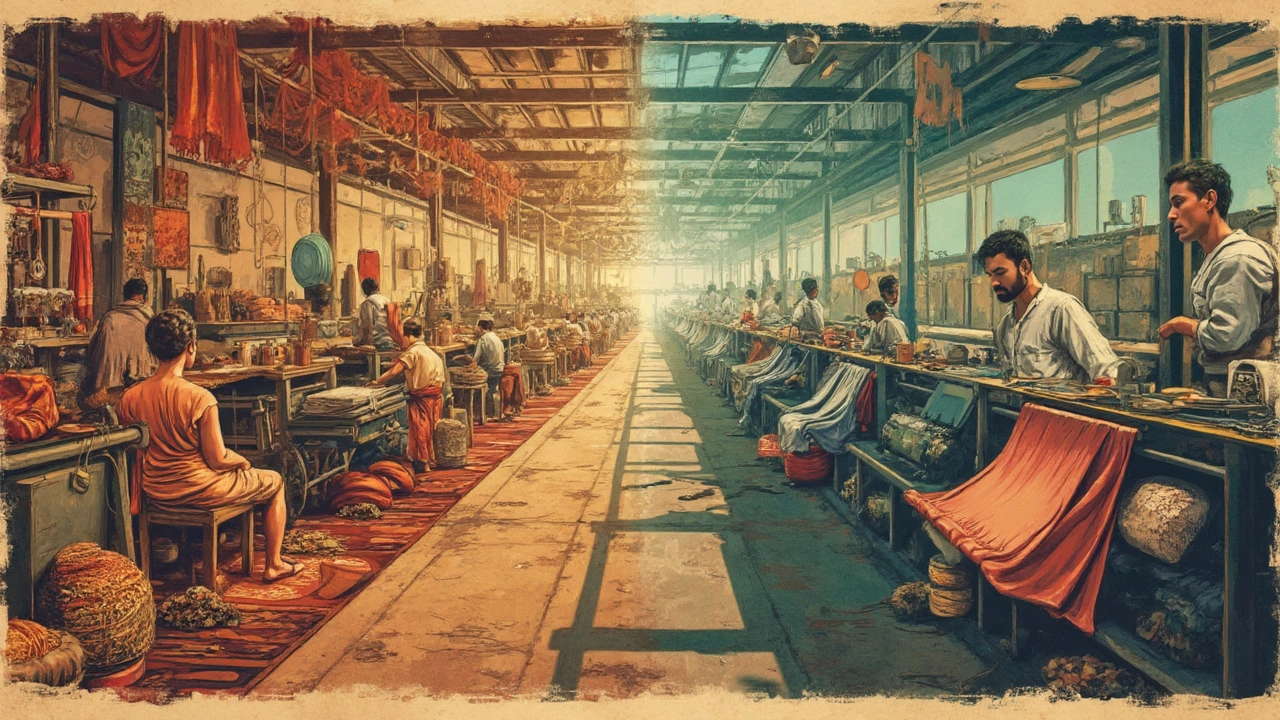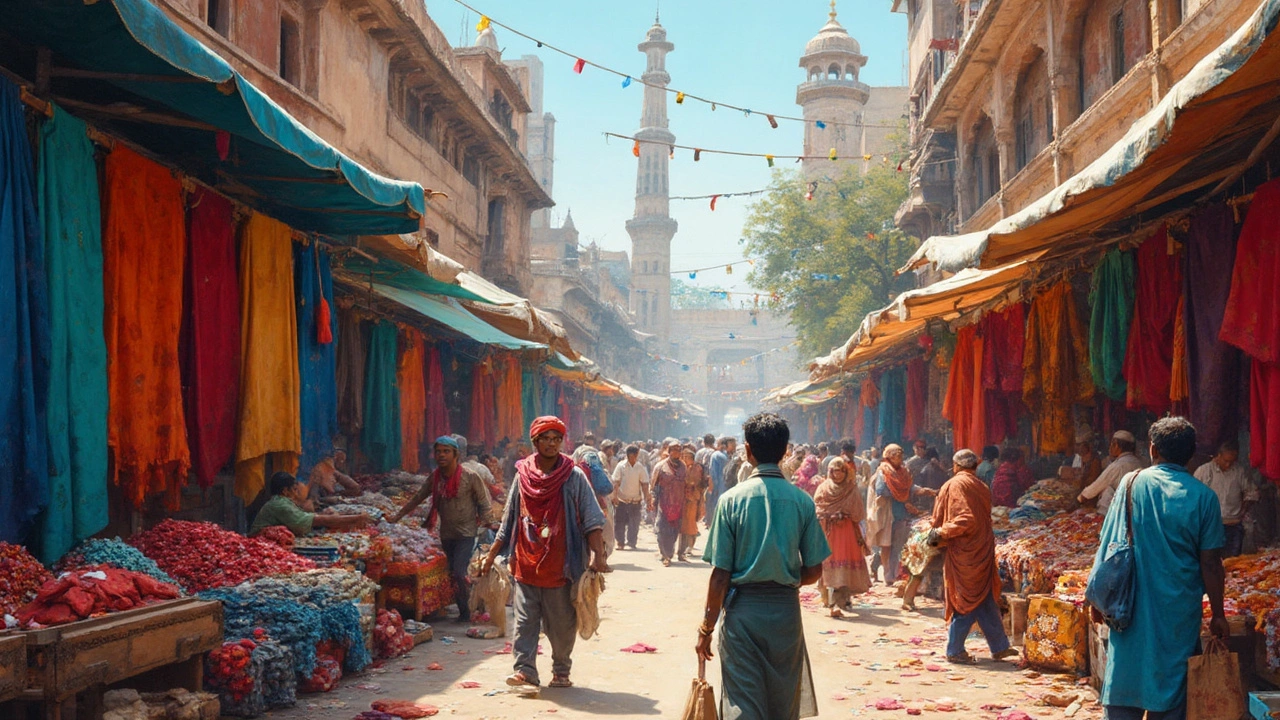Ahmedabad, the bustling city in Gujarat, has quite the reputation when it comes to textiles. Known as the 'Manchester of India', it’s not just a nod to its industrial prowess. Ahmedabad is where tradition meets innovation, churning out some of the finest textiles while keeping its roots firmly planted in history.
So, why is Ahmedabad called a textile city? It all starts with its rich history. For centuries, textiles have been woven into the city's identity, shaping not just its economy but its very culture. It was during the mid-19th century that Ahmedabad started to boom with the establishment of numerous mills. Fast forward to today, and you’ll find a modern hub that blends traditional craftsmanship with cutting-edge technology.
- The Rich History of Textiles in Ahmedabad
- Why Ahmedabad is Called the Manchester of India
- The Role of Technology in Ahmedabad's Textile Industry
- Current Trends and Future Outlook for Ahmedabad Textiles
The Rich History of Textiles in Ahmedabad
Ahmedabad's journey into the textile world is nothing short of fascinating. It all kicked off back in the mid-19th century when the city started emerging as a major player in the textile sector. By 1861, the first cotton textile mill set the wheels in motion, paving the way for numerous others to follow. This city quickly became the place to be for textile manufacturing in India.
What could be more vivid than the name ‘Manchester of India’? Cotton was the star of the show, with the region's climate, rich black soil, and skilled local labor force playing a pivotal part in boosting Ahmedabad's textile fame.
Then came the 20th century, and the city was bustling with vibrant textile mills. At its peak during the 1920s, Ahmedabad had over 60 mills in operation. The sector employed thousands, transforming the city into a bustling textile hub full of energy and innovation.
But it wasn’t always smooth sailing. The industry faced its fair share of ups and downs, especially post-independence in 1947. Despite the challenges like labor strikes and regional competition, Ahmedabad managed to pull through, adapting and evolving with the changing times.
If you're curious about the numbers, here's a snapshot of a specific period:
| Year | Number of Mills |
|---|---|
| 1920 | 63 |
| 1950 | 53 |
| 1980 | 37 |
Today, the textile industry of Ahmedabad is a blend of its rich heritage and modern advancements, standing as a testament to its resilience and adaptability over the decades. The legacy of those early mills, combined with recent technological upgrades, keeps Ahmedabad thriving as a textile powerhouse.
Why Ahmedabad is Called the Manchester of India
Ever wondered why Ahmedabad has earned the nickname 'Manchester of India'? It's all about its thriving textile industry. Back in the 19th century, just like Manchester, Ahmedabad saw a boom with its cotton mills. These weren't just ordinary mills; they played a significant role in not just the local, but the national economy.
Located near the Sabarmati River, the city had easy access to all the water needed for processing cotton. Plus, the climate was perfect for the job. It wasn't long before the city's mills were producing vast amounts of cotton fabrics. A lot of people in India and around the world saw that this placed Ahmedabad on the textile map big time.
Another reason is the city's strategic location and strong connections. Being well-connected by rail and road made transporting textiles easier and cheaper. The workforce here is skilled, carrying a legacy passed down from generations. No wonder multinational companies now find Ahmedabad such an attractive spot for manufacturing!
In terms of volume, Ahmedabad's textile production shares similarities with Manchester during its own boom period. This parallel in productivity and industrial capability is precisely why Ahmedabad relishes in this endearing title today. So, when you think about textile manufacturers in India, remember just how central Ahmedabad is to that story.

The Role of Technology in Ahmedabad's Textile Industry
When it comes to staying ahead in the textile game, Ahmedabad has embraced technology like no other. The city's transition from traditional methods to modern machinery has been nothing short of impressive. Walk into any textile mill here, and you'll see the magic happening—sprawling automated looms and sophisticated dyeing machines making the process faster and more efficient.
One of the standout tech advancements has been in the area of digital printing. Gone are the days where printing designs on fabric took hours. Thanks to digital tech, designs are transferred quickly and with pinpoint accuracy, allowing manufacturers to churn out fresh and vibrant patterns almost at the click of a button.
Additionally, efforts around sustainable technology have gained traction. Many manufacturers are investing in eco-friendly machinery that reduces waste and minimizes environmental impact. Water-efficient processes and energy-saving infrastructures are becoming the norm, which is crucial given the global push for sustainable manufacturing.
Automation also plays a vital role. With automated cutting and stitching, production lines have become more streamlined, reducing human error and upping the production speed. This not only helps meet the rising demand but also ensures high-quality products leaving the factories.
Here’s a quick look at a few of the key technological advancements shaping Ahmedabad’s textile industry:
- Advanced Looms: Modern looms reduce labor costs and increase output.
- 3D Knitting Technology: Opens new possibilities in design and texture.
- Computer-Aided Design (CAD): Facilitates precise and innovative patterns.
Of course, these advancements are not just limited to machinery. The use of big data analytics helps these manufacturers anticipate market trends and adjust accordingly. Predictive analytics is a game-changer, allowing data-driven decisions in a field traditionally dominated by gut feeling.
This tech-driven mindset is why textile manufacturers in Ahmedabad remain competitive, proving once again why this city is a vital cog in the wider fabric of the industry.
Current Trends and Future Outlook for Ahmedabad Textiles
Right now, the textile industry in Ahmedabad is buzzing with innovation and change. With the rise of sustainable fashion, many manufacturers are turning to eco-friendly processes. You’ll find a big push towards using organic cotton and natural dyes, making the industry not only significant for textiles but also for sustainable practices.
A key trend is the integration of technology. Smart textiles, which incorporate electronic components for added functionality, are gaining traction. Local manufacturers are hopping on this tech train, experimenting with AI and IoT to streamline production and boost quality.
The city is also seeing a shift in workforce dynamics. Young entrepreneurs and start-ups are bringing fresh ideas to the table, driving a shift towards a more digital marketplace. Platforms for online textile sales are becoming increasingly common, making it easier for businesses to reach global markets.
As for the numbers, according to a 2023 report by the Gujarat Textile Association, there’s been a steady annual growth rate of around 7% in textile exports from the city. This climb is expected to continue as global demand for Indian textiles swells.
Looking ahead, Ahmedabad's textile sector seems poised for a bright future. The focus on sustainability, tech adoption, and young talent is painting a promising picture. As these trends deepen, the city may very well strengthen its status as India's textile powerhouse, keeping it relevant on the global stage.
One interesting tidbit – a recent survey showed 60% of local textile businesses plan to increase their digital presence by the end of the year. This aligns with a global shift towards e-commerce, suggesting local manufacturers are on the right track.
